Party Wall Behaviour and Impact in QUB and Coheating Tests
Abstract
:1. Introduction
1.1. Fabric Performance Gap
1.2. Heat Transfer Coefficient
1.3. Party Walls
1.4. Measurement Methodologies
1.4.1. Coheating
1.4.2. QUB
- QUB measurements undertaken on a multi-family housing unit (apartment) in Sweden. Equation (3) was used to compute HTCadj. The difference between HTCraw and HTCadj was not reported, and no comparative reference measurement was made [27];
- QUB and comparative coheating measurements were performed on 30 homes with party walls as part of the UK government-funded building performance evaluation project SMETER. No adjustment for party wall heat transfer was included in the calculation; 30% of QUB measurements were shown to statistically agree with the coheating test [25].
1.5. Paper Description and Justification
2. Materials and Methods
2.1. Research Design
2.2. Testing Description
2.3. QUB and Coheating Tests
2.4. Accuracy and Precision Metrics
2.5. House B Heating Patterns
- Parallel. Both properties were subject to QUB tests of identical duration, starting temperature and power input;
- Domestic Schedule. The control house was subject to a typical domestic heating schedule mimicking that described in the SAP methodology [7] with heating active between 07:00–09:00 and 16:00–23:00. The temperature setpoint was set to 21 °C downstairs and 18 °C upstairs;
- No Heat Input. No heat input was made into the control house simulating the property being vacant.
3. Results and Discussion
3.1. Raw Measurements
3.2. Party Wall Adjusted Measurements
3.3. Party Wall Heat Flux
3.4. Temperature Evolution
4. Conclusions
Author Contributions
Funding
Data Availability Statement
Acknowledgments
Conflicts of Interest
References
- Parker, J.; Fletcher, M.; Thomas, F.; Miles-Shenton, D.; Brooke-Peat, M.; Johnston, D.; Gorse, C.; Glew, D. Demonstration of Energy Efficiency Potential: Literature Review of Benefits and Risks in Domestic Retrofit Practice and Modelling; Department for Energy Security and Net Zero: London, UK, 2021.
- HM Government. Conservation of Fuel and Power (Approved Document L1A); 2021 Edition Incorporating 2023 Amendments; HM Government: London, UK, 2021.
- Johnston, D.; Miles-Shenton, D.; Farmer, D. Quantifying the domestic building fabric “performance gap”. Build. Serv. Eng. Res. Technol. 2015, 36, 614–627. [Google Scholar] [CrossRef]
- Fitton, R. Building Energy Performance Assessment Based on In-Situ Measurements: Challenges and General Framework (Report); Energy in Building and Communities Programme: Leuven, Belgium, 2021. [Google Scholar]
- Deb, C.; Gelder, L.V.; Spiekman, M.; Pandraud, G.; Jack, R.; Fitton, R. Measuring the heat transfer coefficient (HTC) in buildings: A stakeholder’s survey. Renew. Sustain. Energy Rev. 2021, 144, 111008. [Google Scholar] [CrossRef]
- BS ISO 13789:2017; Thermal Performance of Buildings—Transmission and Ventilation Heat Transfer Coefficients—Calculation Method. BSI: London, UK, 2017.
- BRE. SAP 2012 the Government’s Standard Assessment Procedure for Energy Rating of Dwellings; BRE: Garston, UK, 2014. [Google Scholar]
- Chynoweth, P. The Party Wall Casebook, 1st ed.; Blackwell: Oxford, UK, 2003; Volume 4. [Google Scholar]
- Department for Levelling Up Housing and Communities. English Housing Survey Headline Report 2020–21; Department for Levelling Up Housing and Communities: London, UK, 2021.
- Lowe, R.J.; Wingfield, J.; Bell, M.; Bell, J.M. Evidence for heat losses via party wall cavities in masonry construction. Build. Serv. Eng. Res. Technol. 2007, 28, 161–181. [Google Scholar] [CrossRef]
- Palmer, J.; Terry, N. Looking Critically at Heat Loss through Party Walls. Sustainability 2022, 14, 3072. [Google Scholar] [CrossRef]
- Gorse, C.; Glew, D.; Johnston, D.; Fylan, F.; Miles-Shenton, D.; Smith, M.; Brooke-Peat, M.; Farmer, D.; Stafford, A.; Parker, J.; et al. Core Cities Green Deal Monitoring Project; Department for Energy Security and Net Zero: London, UK, 2017.
- Johnston, D.; Miles-Shenton, D.; Farmer, D.; Wingfield, J. Whole House Heat Loss Test Method (Coheating); Leeds Beckett University: Leeds, UK, 2013. [Google Scholar]
- Jack, R.; Loveday, D.; Allinson, D.; Lomas, K. First evidence for the reliability of building co-heating tests. Build. Res. Inf. 2018, 46, 383–401. [Google Scholar] [CrossRef]
- Stafford, A.; Johnston, D.; Miles-Shenton, D.; Farmer, D.; Brooke-Peat, M.; Gorse, C. Adding value and meaning to coheating tests. Struct. Surv. 2014, 32, 331–342. [Google Scholar] [CrossRef]
- Leeds Sustainability Institute. Regulations and Standards. 2023. Available online: https://www.leedsbeckett.ac.uk/research/leeds-sustainability-institute/regulations-and-standards/ (accessed on 22 March 2023).
- Marshall, A.; Francou, J.; Fitton, R.; Swan, W.; Owen, J.; Benjaber, M. Variations in the U-value measurement of a whole dwelling using infrared thermography under controlled conditions. Buildings 2018, 8, 46. [Google Scholar] [CrossRef]
- Stamp, S.F. Assessing Uncertainty in Co-Heating Tests: Calibrating a Whole Building Steady State Heat Loss Measurement Method; University College London: London, UK, 2016. [Google Scholar]
- Ahmad, N.; Ghiaus, C.; Qureshi, M. Error analysis of QUB method in non-ideal conditions during the experiment. Energies 2020, 13, 3398. [Google Scholar] [CrossRef]
- Alzetto, F.; Pandraud, G.; Fitton, R.; Heusler, I.; Sinnesbichler, H. QUB: A fast dynamic method for in-situ measurement of the whole building heat loss. Energy Build. 2018, 174, 124–133. [Google Scholar] [CrossRef]
- Alzetto, F.; Farmer, D.; Fitton, R.; Hughes, T.; Swan, W. Comparison of whole house heat loss test methods under controlled conditions in six distinct retrofit scenarios. Energy Build. 2018, 168, 35–41. [Google Scholar] [CrossRef]
- Meulemans, J.; Alzetto, F.; Farmer, D.; Gorse, C. QUB/e: A novel transient experimental method for in situ measurements of the thermal performance of building fabrics. In Building Information Modelling, Building Performance, Design and Smart Construction; Springer: Cham, Switzerland, 2017; pp. 115–127. [Google Scholar] [CrossRef]
- Sougkakis, V.; Meulemans, J.; Wood, C.; Gillott, M.; Cox, T. Field testing of the QUB method for assessing the thermal performance of dwellings: In situ measurements of the heat transfer coefficient of a circa 1950s detached house in UK. Energy Build. 2021, 230, 110540. [Google Scholar] [CrossRef]
- Sougkakis, V.; Meulemans, J.; Wood, C.; Gillott, M.; Cox, T. Evaluation of the precision and accuracy of the QUB/e method for assessing the as-built thermal performance of a low-energy detached house in UK. Energy Build. 2022, 255, 111643. [Google Scholar] [CrossRef]
- HM Government. Technical Evaluation of SMETER Technologies (TEST) Project; Department for Energy Security and Net Zero: London, UK, 2022.
- Meulemans, J.; Farmer, D.; Gorse, C.; Cox, T.; Pühringer, T.; Meulemans, J. Validation of external wall retrofit measures based on rapid and accurate in situ measurements. In Proceedings of the Beyond 2020 World Sustainable Built Environment Conference, Gothenburg, Sweden, 9–15 June 2020. [Google Scholar]
- Meulemans, J. An Assessment of the QUB/e Method for Fast In Situ Measurements of the Thermal Performance of Building Fabrics in Cold Climates. In Proceedings of the Cold Climate HVAC 2018, Kiruna, Sweden, 12–15 March 2018. [Google Scholar] [CrossRef]
- Ghiaus, C.; Alzetto, F. Design of experiments for Quick U-building method for building energy performance measurement. J. Build. Perform. Simul. 2019, 12, 465–479. [Google Scholar] [CrossRef]
- Sougkakis, V.; Meulemans, J.; Alzetto, F.; Wood, C.; Cox, T. An assessment of the QUB method for predicting the whole building thermal performance under actual operating conditions. In Proceedings of the International SEEDS Conference 2017: Sustainable Ecological Engineering Design for Society, Leeds, UK, 13–14 September 2017; pp. 123–135. [Google Scholar]
- Stamp, S.; Lowe, R.; Altamirano-Defina, H. An Investigation Into The Role of Thermal Mass on The Accuracy of Co-Heating Tests Through Simulations & Field Results. In Proceedings of the 13th Conference of International Building Performance Simulation Association, Chambery, France, 26–28 August 2013; pp. 39–46. [Google Scholar]
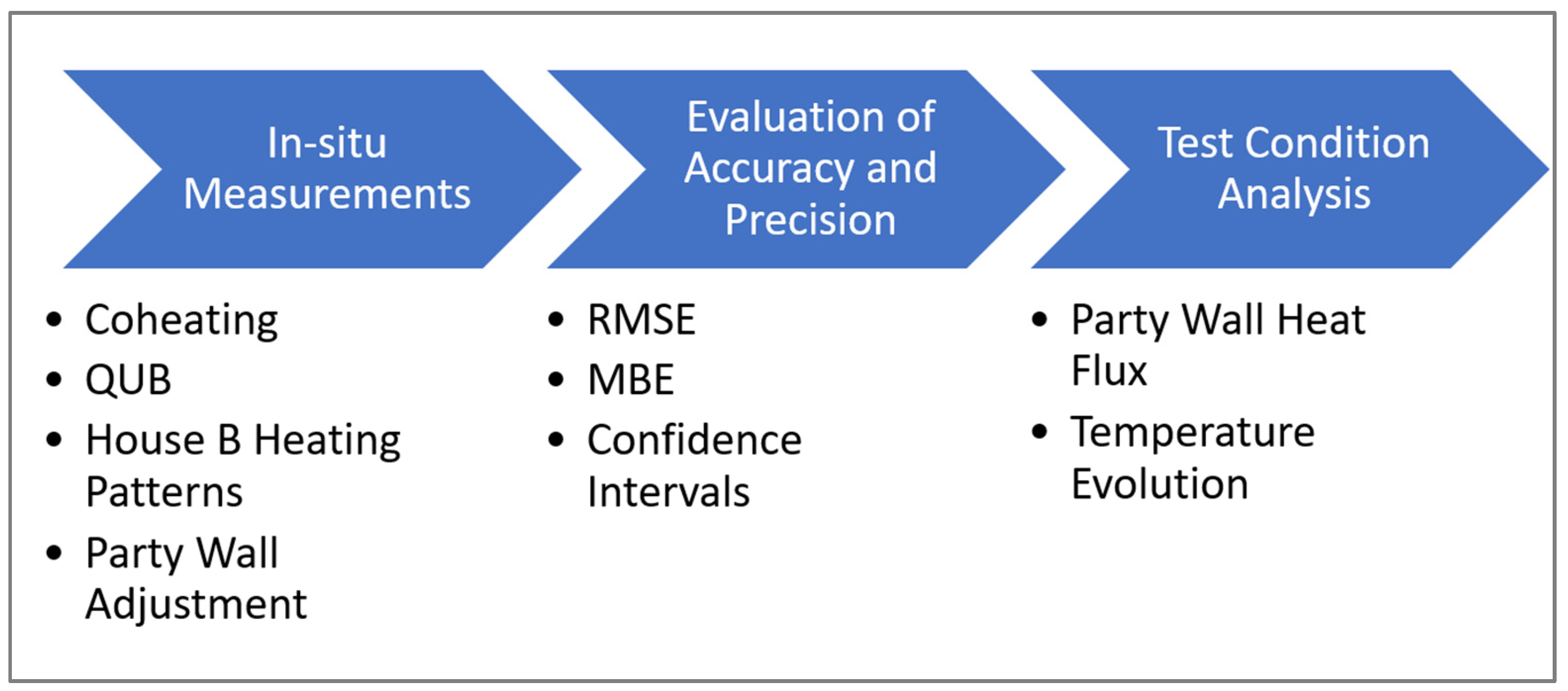


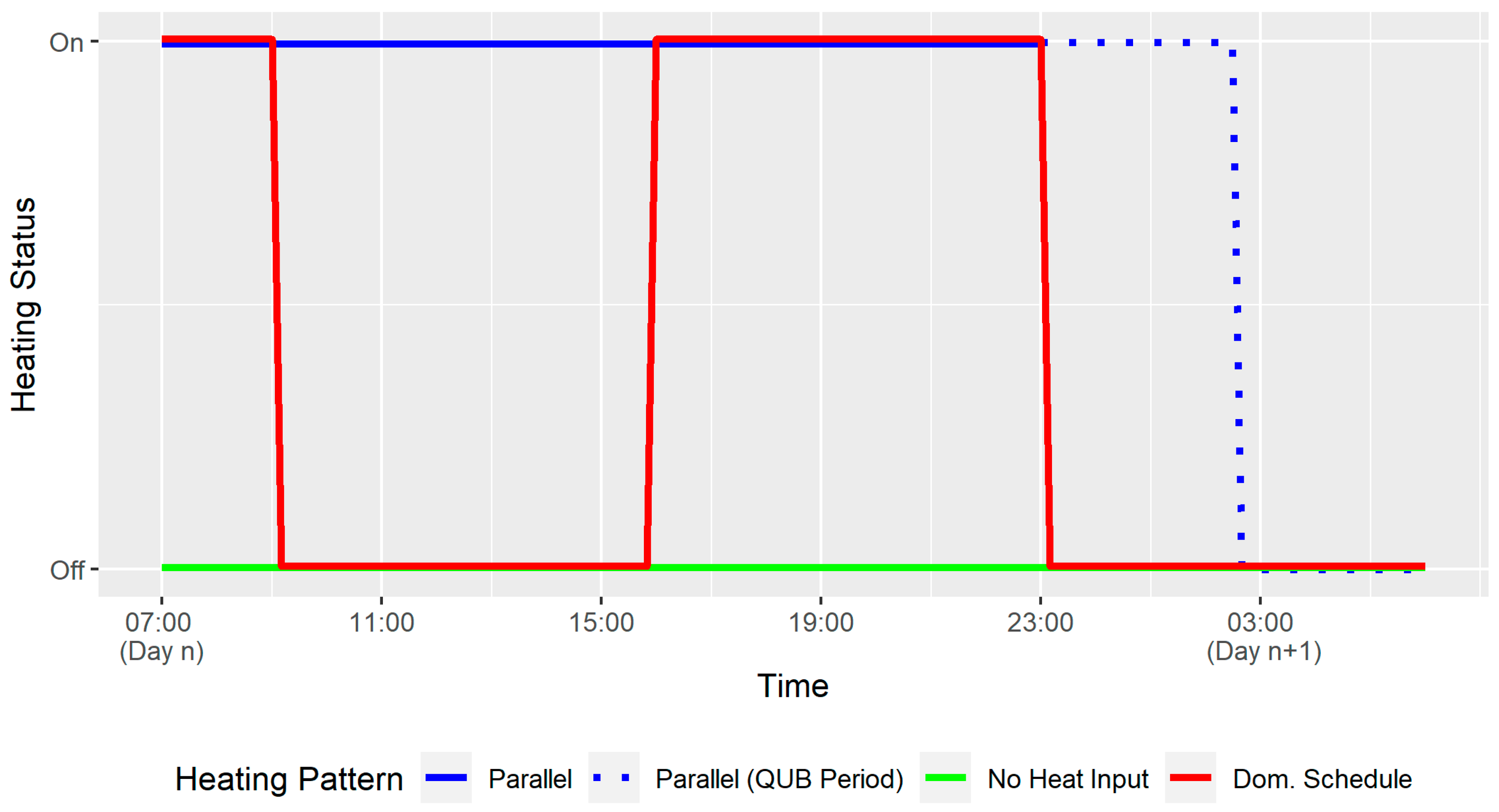
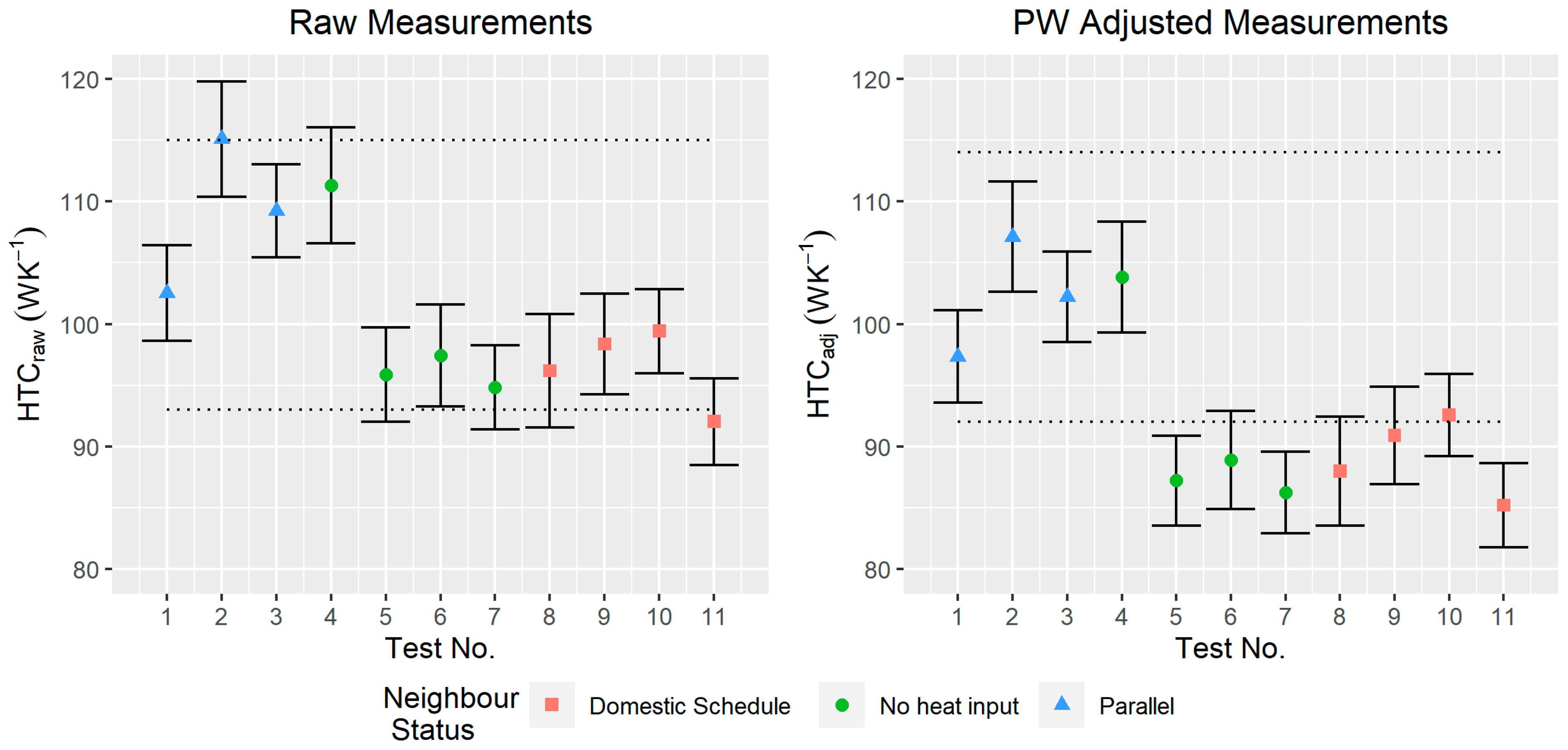

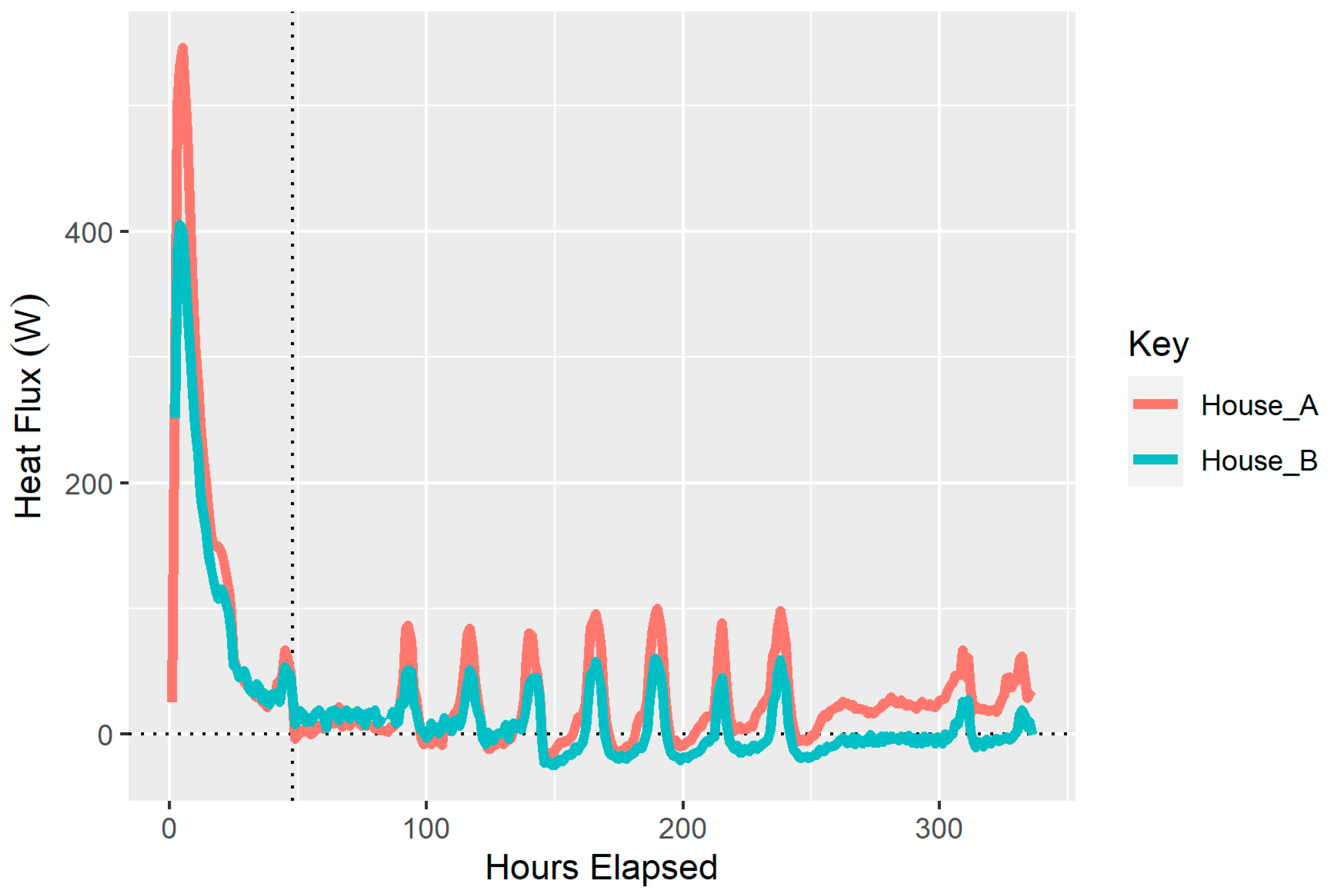
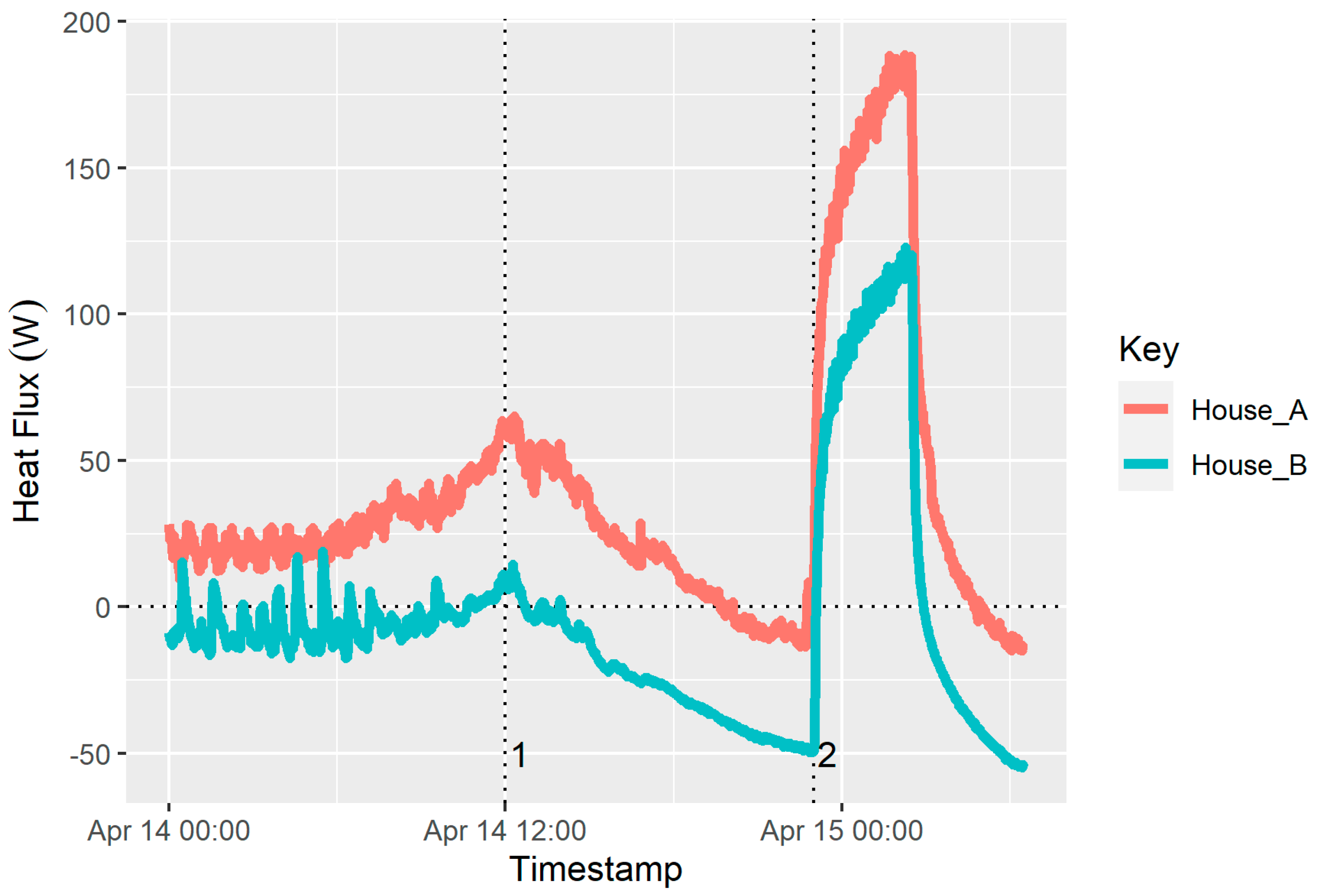
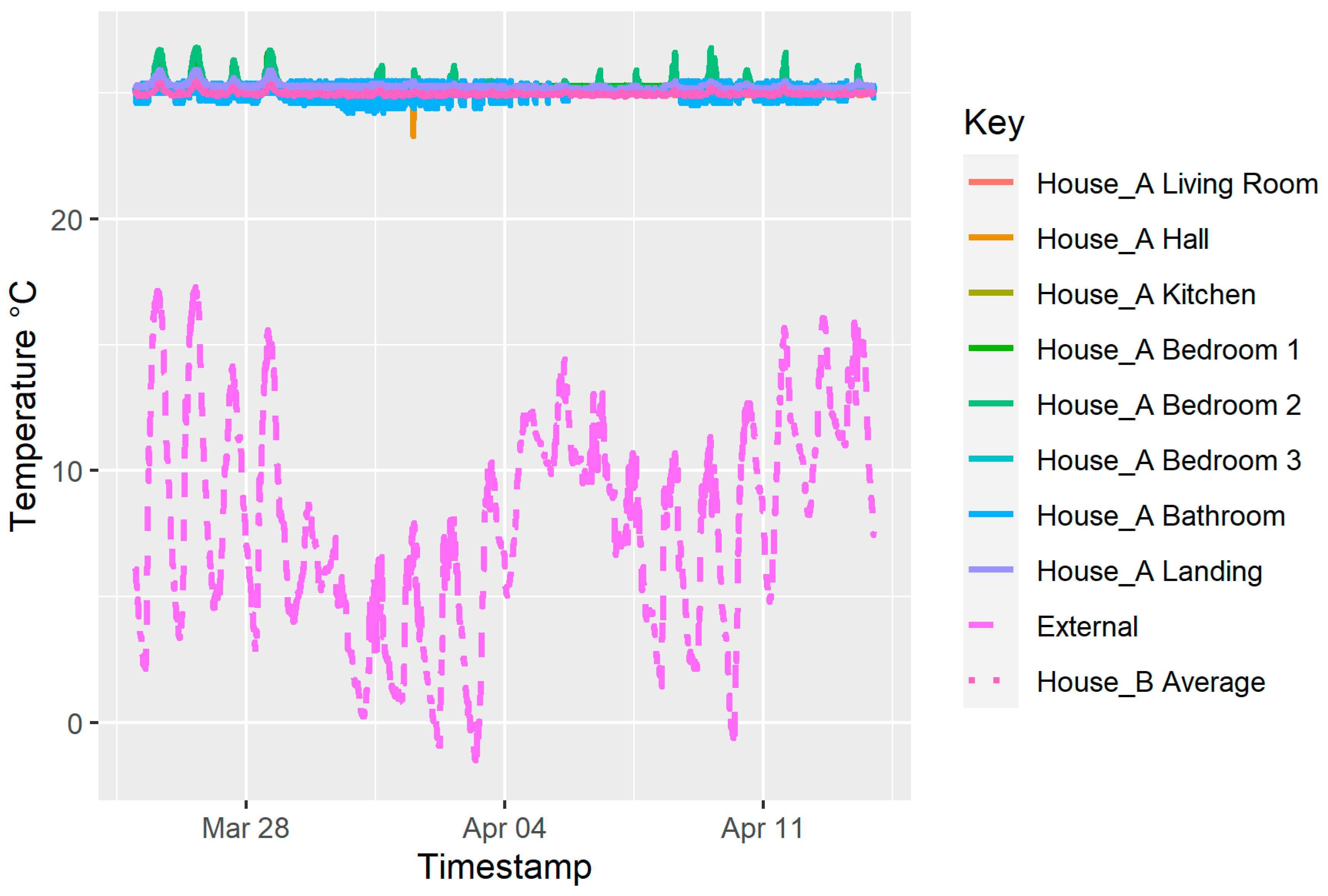

| QUB | Coheating | |
|---|---|---|
| Duration | 2 Days | 14+ days |
| Test Description | HTC is determined through measuring a building’s dynamic thermal response to consecutive heating and free cooling phases that take place overnight. | Quasi-steady state internal conditions are obtained using electric heaters and circulation fans. Multiple linear regression of variables power, ΔText and solar radiation is performed to determine a building’s HTC. |
| Advantages | Relatively short duration makes QUB a practical measurement procedure that could be applied in applications such as new build housing or retrofit. | Since its inception in the 1980s, the procedure has been validated and refined. Consequently, it is reputed as the most reliable HTC measurement procedure. |
| Multiple validation studies have been completed in both field-based and in artificial climates. | Test conditions are optimal for supplementary investigations such as heat flux density measurement and thermography. | |
| Disadvantages | The procedure is relatively modern (first published in 2012). As such, the impact of boundary conditions and building characteristics on the validity of measurements is still being understood. | The procedure’s duration means that it is not practical for applications outside of research. |
| Detail | Description | Measurement |
|---|---|---|
| Floor | Suspended timber floor with 150 mm mineral wool between joists. | 38.9 m2 |
| External Walls | Solid nine-inch brick with external wall insulation system comprised of 8 mm render + 120 mm mineral fibre insulation + 2 mm adhesive. | 75.8 m2 |
| Party Wall | Solid nine-inch brick with 2× chimney breasts. Chimney sealed at base with timber structure enclosing 150 mm mineral wool. | 44.2 m2 |
| Ceiling | Cold pitched roof with 300 mm mineral wool between and above joists. | 39.1 m2 |
| Windows | UPVC Double glazed units. Bay window ceiling insulated with external wall system. | 19.9 m2 |
| Doors | Composite door with double glazed vision panel. | 3.0 m2 |
| Air Permeability | - | 7.8 m3h−1m−2@50 Pa |
| Internal Floor Area | - | 78.0 m2 |
| Internal Volume | - | 207.3 m3 |
| Equipment | Specification | Measurement Uncertainty |
|---|---|---|
| Internal temperature | Pt100 RTD sensor | ±0.3 K |
| External temperature | RHT10E temperature probe | ±0.4 K |
| Solar radiation | Pyranometer | Unidentified |
| Temperature controller | PID Digital temperature controller | ±0.5 K |
| Heater | 2 kW fan heater (Coheating) 500 W fan heater (QUB) | NA |
| Electricity consumption measurement | kWh pulse meter | <±0.1% |
| Temperature and electricity Consumption logging | Wireless data logger * and associated transmitters. | NA |
| Circulation fans | 18 inch diameter circulation fans (Coheating only) | NA |
| Heat flux density measurement | Heat flux plates and wired data logger * | ±0.5% |
| Timer plugs | Digital timer switch (QUB only) | NA |
| Measurand | Average QUB Measurement (WK−1) | Coheating Measurement (WK−1) | RMSE (WK−1) | MBE (WK−1) | Overlapping Measurements |
|---|---|---|---|---|---|
| HTCraw | 100 ± 7 | 104 ± 11 | 8 (7%) | −3 (3%) | 11/11 (100%) |
| HTCadj | 93 ± 7 | 103 ± 11 | 12 (12%) | −9 (9%) | 8/11 (73%) |
Disclaimer/Publisher’s Note: The statements, opinions and data contained in all publications are solely those of the individual author(s) and contributor(s) and not of MDPI and/or the editor(s). MDPI and/or the editor(s) disclaim responsibility for any injury to people or property resulting from any ideas, methods, instructions or products referred to in the content. |
© 2023 by the authors. Licensee MDPI, Basel, Switzerland. This article is an open access article distributed under the terms and conditions of the Creative Commons Attribution (CC BY) license (https://creativecommons.org/licenses/by/4.0/).
Share and Cite
Collett, M.; Hardy, A.; Meulemans, J.; Glew, D. Party Wall Behaviour and Impact in QUB and Coheating Tests. Buildings 2023, 13, 2877. https://doi.org/10.3390/buildings13112877
Collett M, Hardy A, Meulemans J, Glew D. Party Wall Behaviour and Impact in QUB and Coheating Tests. Buildings. 2023; 13(11):2877. https://doi.org/10.3390/buildings13112877
Chicago/Turabian StyleCollett, Mark, Adam Hardy, Johann Meulemans, and David Glew. 2023. "Party Wall Behaviour and Impact in QUB and Coheating Tests" Buildings 13, no. 11: 2877. https://doi.org/10.3390/buildings13112877
APA StyleCollett, M., Hardy, A., Meulemans, J., & Glew, D. (2023). Party Wall Behaviour and Impact in QUB and Coheating Tests. Buildings, 13(11), 2877. https://doi.org/10.3390/buildings13112877







